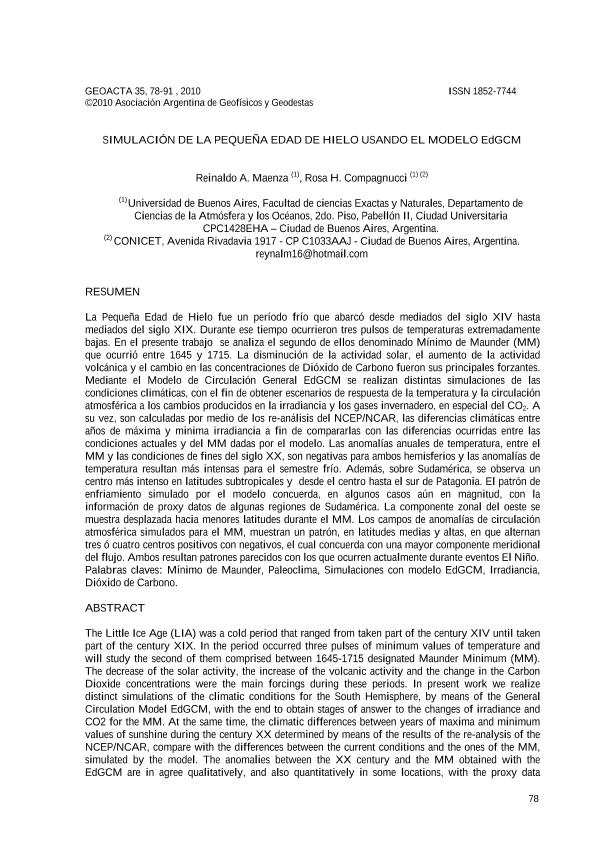Artículo
La Pequeña Edad de Hielo fue un período frío que abarcó desde mediados del siglo XIV hasta mediados del siglo XIX. Durante ese tiempo ocurrieron tres pulsos de temperaturas extremadamente bajas. En el presente trabajo se analiza el segundo de ellos denominado Mínimo de Maunder (MM) que ocurrió entre 1645 y 1715. La disminución de la actividad solar, el aumento de la actividad volcánica y el cambio en las concentraciones de Dióxido de Carbono fueron sus principales forzantes. Mediante el Modelo de Circulación General EdGCM se realizan distintas simulaciones de las condiciones climáticas, con el fin de obtener escenarios de respuesta de la temperatura y la circulación atmosférica a los cambios producidos en la irradiancia y los gases invernadero, en especial del CO2. A su vez, son calculadas por medio de los re-análisis del NCEP/NCAR, las diferencias climáticas entre años de máxima y minima irradiancia a fin de compararlas con las diferencias ocurridas entre las condiciones actuales y del MM dadas por el modelo. Las anomalías anuales de temperatura, entre el MM y las condiciones de fines del siglo XX, son negativas para ambos hemisferios y las anomalías de temperatura resultan más intensas para el semestre frío. Además, sobre Sudamérica, se observa un centro más intenso en latitudes subtropicales y desde el centro hasta el sur de Patagonia. El patrón de enfriamiento simulado por el modelo concuerda, en algunos casos aún en magnitud, con la información de proxy datos de algunas regiones de Sudamérica. La componente zonal del oeste se muestra desplazada hacia menores latitudes durante el MM. Los campos de anomalías de circulación atmosférica simulados para el MM, muestran un patrón, en latitudes medias y altas, en que alternan tres ó cuatro centros positivos con negativos, el cual concuerda con una mayor componente meridional del flujo. Ambos resultan patrones parecidos con los que ocurren actualmente durante eventos El Niño. The Little Ice Age (LIA) was a cold period that ranged from taken part of the century XIV until taken part of the century XIX. In the period occurred three pulses of minimum values of temperature and will study the second of them comprised between 1645-1715 designated Maunder Minimum (MM). The decrease of the solar activity, the increase of the volcanic activity and the change in the Carbon Dioxide concentrations were the main forcings during these periods. In present work we realize distinct simulations of the climatic conditions for the South Hemisphere, by means of the General Circulation Model EdGCM, with the end to obtain stages of answer to the changes of irradiance and CO2 for the MM. At the same time, the climatic differences between years of maxima and minimum values of sunshine during the century XX determined by means of the results of the re-analysis of the NCEP/NCAR, compare with the differences between the current conditions and the ones of the MM, simulated by the model. The anomalies between the XX century and the MM obtained with the EdGCM are in agree qualitatively, and also quantitatively in some locations, with the proxy data information for various regions of the Hemisphere South. The annual temperature anomalies, between the MM and the 20th century ending conditions, are negative for both hemispheres and the temperature anomalies result more intense on semester November-April. Furthermore, over South America, shows a more intense centre in subtropical latitude and central and south Patagonia. The cold pattern obtained by the model is in agreement, on magnitude too, with proxy information obtained in some South America regions. The westerly wind component undergoes a shift to lower latitudes during the MM. The atmospheric circulation anomalies obtained in the simulations, show a pattern, over middle and high latitudes, where alternate three or four positive and negative anomaly centres, which is in agreement with a greater meridional component of the flux. Both patterns are similar to those present during El Niño events.
Simulación de la pequeña Edad de Hielo usando el modelo EdGCM
Fecha de publicación:
12/2010
Editorial:
Asociación Argentina de Geofísicos y Godestas
Revista:
Geoacta
ISSN:
1852-7744
Idioma:
Español
Tipo de recurso:
Artículo publicado
Clasificación temática:
Resumen
Palabras clave:
Mínimo de Maünder
,
Paleoclima
,
Simulaciones con Modelo Edgcm
,
Forzantes
Archivos asociados
Licencia
Identificadores
Colecciones
Articulos(OCA CIUDAD UNIVERSITARIA)
Articulos de OFICINA DE COORDINACION ADMINISTRATIVA CIUDAD UNIVERSITARIA
Articulos de OFICINA DE COORDINACION ADMINISTRATIVA CIUDAD UNIVERSITARIA
Citación
Maenza, Reinaldo Agustín; Compagnucci, Rosa Hilda; Simulación de la pequeña Edad de Hielo usando el modelo EdGCM; Asociación Argentina de Geofísicos y Godestas; Geoacta; 35; 2; 12-2010; 78-91
Compartir




